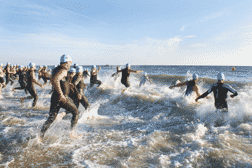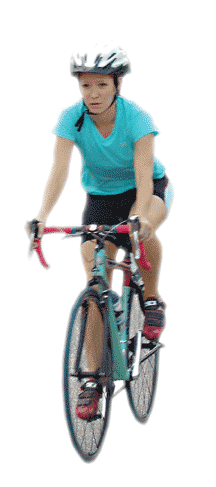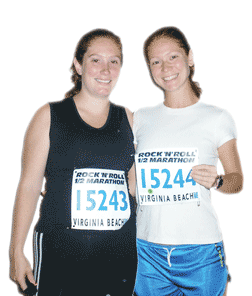 |
||||||||||
|
||||||||||
|
||||||||||
TRI-umphSuccess in this competition is about more than fast times or athletic prowessby Kat Burke
“I’m really nervous,” I confessed through foggy goggles to a stranger in a red swim cap matching mine. “Just relax and have fun,” she smiled, as salt water sprayed our faces. Within seconds, at the shouted command GO, I followed a swarm of female athletes into the water for a quarter-mile ocean swim, the first leg of the annual Cape Henlopen Triathlon and Duathlon in Lewes, Delaware. I was a first-time triathlete among a hundred women, novices to veterans. The men — including my fiancé, another first-time triathlete — would start five minutes after us. Their white caps peppered the beach as our red ones bobbed in the 74-degree water. Immersed in the ocean, I tried to heed the stranger’s advice. In under two hours, it would be over. After the swim … after the 15-mile bike ride … after the 3.1-mile run … we’d have proved something — to ourselves and each other. That thought sustained me as I checked in, alongside my fiancé and my sister, a first-time duathlete, and we were tattooed in semi-permanent black ink with our race markings Her race, which replaced the swim leg with a 1.5-mile run, began five minutes before mine. She’d already given me her well wishes. My fiancé’s white cap was one of many on the shore I’d left behind. I was on my own. Some of these athletes would finish over 20 minutes before me. Many were competing for cash prizes and trophies. What was I doing here?
Making the CommitmentI run a few times a week. I stay in shape. I’ve done the occasional road race. But I am not an elite athlete. So when my fiancé proposed a triathlon, I laughed. Triathlons are for professionals, for real athletes. After a year of excuses, we found the event at Cape Henlopen, with a shorter swim distance than the average sprint triathlon. Soon as I registered, I felt different. I was anxious, but I was also proud. The triathlon became a part of our daily lives beyond the workouts. I told everyone I was in training. I liked saying it, as though registering alone was reason to boast. People I’d just met offered words of encouragement. Experienced triathletes beamed. My head was ready, but was my body? After every workout, I wondered if I could prevail. Diving InIn the water, it was too late to drop out. I took a deep breath and fixed on the yellow buoy that was our goal. Ocean swimming felt different than the pool training. In the safe, wide lap at the Arundel Olympic Swim Center, I could stop whenever I needed. No one swam close enough to me to disturb the water, much less run into me. But off the Delaware shore, even the seemingly calm water tossed me into other swimmers. I was kicked and hit by flying elbows for the first hundred meters. “First-time athletes do fine once they get over that initial fear of ocean swimming,” said race director Neil Semmel, owner of Piranha Sports. Intimidated by the current, athletes forget that swimming in salt water can provide more buoyancy and speed. Remembering those words, I gasped for breath and tried to relax, to keep my head down and my body up, as I had learned in practice. Among the white caps was my fiancé. Ron had learned the freestyle swim stroke just two months ago, logging countless, frustrated hours at the pool. Now he, too, was in the ocean, swimming against the resistance of the choppy water. In the pool, as better swimmers lapped us, we feared the embarrassment of emerging last from the swim leg. In the Atlantic, I didn’t care if I came out of the water first or last. Making it through the swim was accomplishment enough. Swallowing PrideStrangers clapped for me as I rose from the salty water onto the sandy shore. The sun burned my eyes, and my feet sunk in the deep sand as I began the quarter-mile run to the transition area. I was struggling when a voice from behind asked if I needed help to unzip my wetsuit. At my tired nod, she stopped her jog to undo my tight zipper before unzipping herself. Many of us wore wetsuits. Had water temperature been a few degrees warmer, they would have been prohibited because of their added buoyancy. Underneath the skin-tight suit, I donned a conservative one-piece Nike swimsuit. My sister and I had tried on a variety of revealing triathlon-friendly outfits. Many women had chosen two-piece triathlon suits, made of quick-drying fabric and padded at the bottom for the hard bike seat. Most men wore similar one-piece suits for the entire race. Every option was far more revealing than the baggy shorts and T-shirt I’d trained in. Body image issues don’t survive long in competition. Men and women of all shapes and sizes, from petite to extra-large, wore the fitted, unforgiving clothes without apologies. After the race, no one rushed to cover up. The athletes were more concerned with how they felt than with how they looked. Shifting GearsI pushed my bike to the Mount sign before jumping on. Mounting before permission can cause penalties and accidents. In a pre-race meeting, I’d learned the bike rules, including staying at least three bike lengths behind the cyclist in front and to the right of the lane to allow faster riders to pass safely. I was on the bike less than a minute when a string of men whizzed past on my left, further proof that winning such a race was beyond my capabilities. I settled into a pace and let the breeze meet my bare arms. Throughout the ride I was grateful for the flat terrain of coastal Delaware. On the shoulder of thin winding roads, I pedaled and watched fields and farmhouses fly by. I passed a few women, one a cyclist in a white shirt. My sister shouted my name. Triathletes had merged with the duathletes. All of us were in it together, now. My legs hurt, so I tried not to think about the run I still had to do. Though I missed the encouragement of my training partner, athletes ahead and behind reminded me that I wasn’t alone. Gearing UpThe top finishers averaged over 26 miles per hour on the bike leg. Their speed and stamina came from commitment, training, talent — and a great bike. Beginning triathletes, I discovered, do not need such a bike. Until entering this race, I had never gotten on a road bike without falling off. The frames are light, the seats are high, the shoes clip to the pedals and the tires are thin to promote speed. They are hard to ride. I trained for six weeks on a hybrid, a cross between a road bike and a dirt bike. Its heavier frame and thicker tires make it easier to ride and more durable. And slower. At the insistence of an experienced cyclist, I tried a road bike adjusted to my height. With the same amount of effort, I pedaled two or three miles faster per hour. I was hooked. Distinctions exist even among road bikes, which range from $1,500 to over $10,000. I was able to buy a used road bike at a good price; however, first-time triathletes don’t need a road bike to compete. Several competitors, including my sister, used hybrid bikes, running closer to $500. The proper fit is as important as the type of bike. Improper seat positioning can cause inefficient use of energy and strain on joints and muscles. For 15 miles, comfort is also a consideration. Athletes not racing for a spot on the pedestal can afford to take on the extra weight of a padded seat cover and a second water bottle. I wished I’d added sunglasses so I could stop squinting, for my helmet provided only minimal protection from the bright sun.
Building Brick by BrickI’d filled my extra bottle with Gatorade and gulped it after I’d finished the bike leg. The sugar and electrolytes would be enough to keep my muscles moving through the final leg of the triathlon. I tied my shoes and ran out. The 5K run brought us through a wooded path that protected my tired eyes against the blinding sun. The sounds of labored breathing and pounding footsteps echoed off the tall trees. My legs were sluggish from the cycling, and I was, again, missing my training partner, who talked me through tough workouts. We’d used brick training, biking and then running during practice to simulate what your muscles feel on race day. I knew the heaviness in my legs would give way in a few minutes as my muscles adjusted. Though in pain, I felt proud to be in this group. We’d all been through the same thing that day. Taking comfort knowing that mine were not the only legs that hurt, I focused on the three-mile journey ahead. No Walking AllowedIt’s easy to quit during the run leg of a triathlon. It comes last. You are tired from the first two legs. All you have to do is walk. A mile into the run, I slowed down. Just don’t walk, I kept saying in my head. This had been my only goal for the run. At my slow jog, I passed an older man, also jogging. Through heavy breaths, he sputtered encouragement. Was his goal also to avoid walking? I felt energized to see the diversity around me and speculated on the many personal triumphs. Just before the second mile, I saw my fiancé. I’d made a turn and was passing runners when I came upon him. As we breathed words of encouragement, I realized we were both going to finish what we started that day. Turning a corner out of the woods, I again emerged into the bright daylight. At the end of a grassy field, an inflatable archway covered the finish line. Strangers cheered as I approached. They didn’t come to see me; they’d come for someone else or were competitors themselves, already finished. Yet they yelled my number and clapped like I was their daughter or wife or best friend. I crossed the line. After I turned in my timing chip and grabbed a welcome bottle of water, I headed back to join the cheering. Well after every athlete had crossed under the archway, I surveyed the scene. The crowd of competitors and spectators smiled and shook hands in congratulations. My sister, my fiancé and I joined other racers, gobbling sandwiches and posing for pictures. The three of us had come to this race wondering if we were athletes enough to belong here. We left knowing that we had earned the right to be here. Yet our success had less to do with fast times or athletic prowess than with the respect we’d gained for ourselves — and for anyone else willing to try such a challenge. As the throng of racers disbursed, another tired, exultant woman spoke to me. She said she’d kept her eye on my back for the last leg. “You’re what got me through,” she said. Kat Burke is a high-school English teacher and novelist who writes from Annapolis. Her last feature for Bay Weekly was “A Place to Call Home: Chipping and Dipping for Davidsonville Wildlife Sanctuary” (Vol. xv, No. 39: Sept. 27). |
||||||||||
|
||||||||||
|
|
||||||||||
|
© COPYRIGHT 2007 by New Bay Enterprises, Inc. All rights reserved. |
||||||||||


